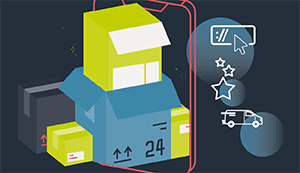
As countries around the world continue to grapple with COVID-fueled closures, more customers than ever are doing their shopping online. In many cases, this shift will be a permanent one, with Accenture predicting delivery companies will retain up to 50% of the peak volume they have experienced this year.
If you’re the owner of a classic Brick and Mortar retail business, it’s time to consider building an online presence. Pivoting to an online business can seem daunting, but it doesn’t have to be. We’ve put together a guide that outlines 7 simple steps to get you started.
1. Determine your shipping fees
Once you’ve decided which items you want to sell online, the next step is figuring out a pricing model for shipping. High delivery fees can deter customers, but on the other hand, taking on too much cost yourself can quickly eat into profit margins. Either way, it’s important to factor shipping into your overall pricing strategy.
It’s also important to price your shipping in a way that’s consistent, and easy for your customers to understand. According to Metapack’s own research, 79% say free delivery is important to them, even if it comes with a minimum spend requirement. Many retailers can provide this by simply injecting the fees into the item cost.
That said, free shipping isn’t the only way. Many retailers choose to offer flat-rate shipping per shipment, which is a convenient and fair alternative for customers.
2. Offer several shipping options
Metapack’s eCommerce Delivery Benchmark Report 2020 reveals that 27% of consumers buy from one retailer over another due to better delivery options. In other words, delivery is becoming a strong differentiator in a competitive online marketplace.
Online shoppers want to receive their parcel in a way that suits them, whether that’s next-day delivery to their door, pick up in-store, or at a PUDO point on their way to work. Customers want delivery options to match their priorities – whether it’s speed, cost, or even environmental impact that matters most.
Building up a network capable of delivering on these complex fulfillment requirements can be challenging, especially when retailers are just starting out. Delivery Management platforms can connect retailers to a wide range of carriers and shipping services, providing a ready-made ecosystem capable of delivering on the diverse delivery preferences of every customer.
3. Set up an online store
If you plan on selling online beyond COVID-19, there are many options available. You may find some free platforms – these are generally shopping carts that require you to host the website yourself, and that generally require a lot of development work and extensive build time.
You’ll also need to set up a payment processor that’s easy to use, and which offers a range of features that can help grow your online selling presence. When selecting a provider, consider whether you require a plug-and-play solution, or if you have the in-house developer resources required for more bespoke solutions.
4. Showcase your products effectively
One of the obvious disadvantages of moving your business online is that your customers lose the ability to interact with your products directly. As such, you need to create a greater sense of engagement with your products through meaningful photography and copy. A good product description should give customers the best understanding of what they’re buying. Listing product dimensions as well as what is included with their purchase can be a way of incentivizing customers while also reducing complaints or chargeback.
5. Achieve PCI Compliance
PCI DSS compliance (Payment Card Industry Data Security Standard) is a mandate required by credit card companies to securely accept and process online payments. You’ll need to check the different levels of compliance for each card company. For more information about PCI compliance, you can also check out the official website.
6. Consider GDPR and CCPA Compliance
Data privacy is an evolving field. Ultimately, these laws allow any person that lives in Europe (GDPR) or California (CCPA) to have the right to have personal data erased from your system and any other system you integrate with. For more information on compliance with these acts, head to gdpr-info.eu/ and oag.ca.gov/privacy/ccpa.
7. Create a process for taxes
One of life’s certainties, of course, stretches into ecommerce. Luckily, you have options. No matter which system you choose, you will need to properly charge and file taxes.
The All-Delivery Era has arrived, and more customers than ever want to experience your brand online. Building your own presence online doesn’t have to be daunting – having a Bricks and Mortar operation at the ready is already half the battle. By following these simple steps you’ll already be well on your way to expanding into ecommerce, and tapping into the opportunities in this space that are bigger than ever.
Find out more about the All-Delivery Era, and how you can scale your ecommerce supply chain to take advantage of the demand. Download the Metapack eCommerce Delivery Benchmark Report 2020.

